Deck 11: Flammable and Explosive Materials
Question
Question
Question
Question
Question
Question
Question
Question
Question
Question
Question
Question
Question
Question
Question
Question
Question
Question
Question
Question
Question
Question
Question
Question
Question
Question
Question
Question
Question
Question
Question
Question
Question
Question
Question
Question
Question
Question
Question
Question
Question
Question
Question
Question
Question
Question
Question
Question
Question
Question
Question
Question
Question
Question
Question
Question
Question
Question
Question
Question
Question
Question
Question
Question
Question
Question
Question
Question
Question
Question
Question
Question
Question
Question
Question
Question
Question
Question
Question
Question

Unlock Deck
Sign up to unlock the cards in this deck!
Unlock Deck
Unlock Deck
1/88
Play
Full screen (f)
Deck 11: Flammable and Explosive Materials
1
17.All combustible liquids are Class II liquids.
False
2
13.Classification of flammable liquids does not depend upon boiling point.
False
3
21.Class III B liquids are not classified by OSHA standards as "hazardous substances."
True
4
7.Which of the following is best classified as a Class B explosive?
A)nitroglycerin
B)dynamite
C)black powder
D)propellant
A)nitroglycerin
B)dynamite
C)black powder
D)propellant

Unlock Deck
Unlock for access to all 88 flashcards in this deck.
Unlock Deck
k this deck
5
16.All Class I liquids are flammable liquids.

Unlock Deck
Unlock for access to all 88 flashcards in this deck.
Unlock Deck
k this deck
6
22.The ignition temperature for gasoline is higher than for paper.

Unlock Deck
Unlock for access to all 88 flashcards in this deck.
Unlock Deck
k this deck
7
3.What two physical characteristics of a liquid are principally used to determine its flammability classification?
A)flashpoint and boiling point
B)flashpoint and firepoint
C)boiling point and firepoint
D)volatility and boiling point
A)flashpoint and boiling point
B)flashpoint and firepoint
C)boiling point and firepoint
D)volatility and boiling point

Unlock Deck
Unlock for access to all 88 flashcards in this deck.
Unlock Deck
k this deck
8
9.Which of the following is best classified as a Class C explosive?
A)black powder
B)propellant
C)photographic flash powder
D)explosive rivets
A)black powder
B)propellant
C)photographic flash powder
D)explosive rivets

Unlock Deck
Unlock for access to all 88 flashcards in this deck.
Unlock Deck
k this deck
9
15.All flammable liquids are Class I liquids.

Unlock Deck
Unlock for access to all 88 flashcards in this deck.
Unlock Deck
k this deck
10
8.Which of the following is best classified as a Class A explosive?
A)black powder
B)propellant
C)photographic flash powder
D)explosive rivets
A)black powder
B)propellant
C)photographic flash powder
D)explosive rivets

Unlock Deck
Unlock for access to all 88 flashcards in this deck.
Unlock Deck
k this deck
11
20.Some flammable liquids are Class III liquids.

Unlock Deck
Unlock for access to all 88 flashcards in this deck.
Unlock Deck
k this deck
12
4.What principal physical characteristic of gasoline makes it particularly hazardous to have basements in service stations?

Unlock Deck
Unlock for access to all 88 flashcards in this deck.
Unlock Deck
k this deck
13
11.The definition of "liquid" by NFPA as far as flammable liquids are concerned has little to do with vapor pressure.

Unlock Deck
Unlock for access to all 88 flashcards in this deck.
Unlock Deck
k this deck
14
12.Flashpoint is the temperature at which a fire on top of the liquid is sustained.

Unlock Deck
Unlock for access to all 88 flashcards in this deck.
Unlock Deck
k this deck
15
18.All combustible liquids are Class III liquids.

Unlock Deck
Unlock for access to all 88 flashcards in this deck.
Unlock Deck
k this deck
16
5.What is the principal criterion for determining whether wiring for flammable paint spray areas must be Class I Division 1 or Division 2?

Unlock Deck
Unlock for access to all 88 flashcards in this deck.
Unlock Deck
k this deck
17
6.The proper wiring selection for areas twenty feet or more away from flammable paint spray booths is:
A)Class I,Division 1
B)Class I,Division 2
C)Class II,Division 1
D)conventional wiring
A)Class I,Division 1
B)Class I,Division 2
C)Class II,Division 1
D)conventional wiring

Unlock Deck
Unlock for access to all 88 flashcards in this deck.
Unlock Deck
k this deck
18
19.All Class II liquids are combustible liquids.

Unlock Deck
Unlock for access to all 88 flashcards in this deck.
Unlock Deck
k this deck
19
1.What two physical characteristics of a liquid are principally used to determine its flammability classification?

Unlock Deck
Unlock for access to all 88 flashcards in this deck.
Unlock Deck
k this deck
20
14.Volatility of a liquid bears a close relationship to the boiling point of a liquid.

Unlock Deck
Unlock for access to all 88 flashcards in this deck.
Unlock Deck
k this deck
21
23.An empty tank can be more dangerous than a tank full of gasoline.

Unlock Deck
Unlock for access to all 88 flashcards in this deck.
Unlock Deck
k this deck
22
39.Use of a carbon dioxide fire extinguisher can subject the user to electrical shock.

Unlock Deck
Unlock for access to all 88 flashcards in this deck.
Unlock Deck
k this deck
23
31.Gasoline vapors are lighter than air and will th

Unlock Deck
Unlock for access to all 88 flashcards in this deck.
Unlock Deck
k this deck
24
33.High octane aviation gasoline is more flammable than ordinary "regular" gasoline.

Unlock Deck
Unlock for access to all 88 flashcards in this deck.
Unlock Deck
k this deck
25
37.When dispensing Class I liquids into plastic containers,NFPA regulations require electrical bonding.

Unlock Deck
Unlock for access to all 88 flashcards in this deck.
Unlock Deck
k this deck
26
27.Alcohol will ignite inside a drum more readily than gasoline will.

Unlock Deck
Unlock for access to all 88 flashcards in this deck.
Unlock Deck
k this deck
27
25.Gasoline will ignite at leaner concentrations than alcohol will.

Unlock Deck
Unlock for access to all 88 flashcards in this deck.
Unlock Deck
k this deck
28
34.A broken light bulb can ignite vapors of flammable liquids.

Unlock Deck
Unlock for access to all 88 flashcards in this deck.
Unlock Deck
k this deck
29
40."Splash loading" generates static electricity.

Unlock Deck
Unlock for access to all 88 flashcards in this deck.
Unlock Deck
k this deck
30
30.If space permits,the safest place to locate tanks of gasoline is outside in overhead tanks.

Unlock Deck
Unlock for access to all 88 flashcards in this deck.
Unlock Deck
k this deck
31
29.Underground tanks of gasoline will not sustain combustion.

Unlock Deck
Unlock for access to all 88 flashcards in this deck.
Unlock Deck
k this deck
32
38.Filling tanks or containers generates static electricity due to the flow of the liquid.

Unlock Deck
Unlock for access to all 88 flashcards in this deck.
Unlock Deck
k this deck
33
42.Static electrical discharge is a source of ignition for flammable liquid vapors.

Unlock Deck
Unlock for access to all 88 flashcards in this deck.
Unlock Deck
k this deck
34
35.Flammable liquid tank design is an engineering function and is th

Unlock Deck
Unlock for access to all 88 flashcards in this deck.
Unlock Deck
k this deck
35
28.Fires in underground gasoline tanks burn or explode with such intensity as to destroy much life and property around service stations.

Unlock Deck
Unlock for access to all 88 flashcards in this deck.
Unlock Deck
k this deck
36
36.Floating roof tanks are more hazardous than fixed roof tanks.

Unlock Deck
Unlock for access to all 88 flashcards in this deck.
Unlock Deck
k this deck
37
24.Gasoline/air mixtures in which the gasoline vapors are held to less than 5% are considered safe.

Unlock Deck
Unlock for access to all 88 flashcards in this deck.
Unlock Deck
k this deck
38
26.Alcohol will ignite at richer concentrations than gasoline will.

Unlock Deck
Unlock for access to all 88 flashcards in this deck.
Unlock Deck
k this deck
39
41.A "rest area" expansion chamber in a liquid flow line permits static electricity to bleed off.

Unlock Deck
Unlock for access to all 88 flashcards in this deck.
Unlock Deck
k this deck
40
32.Natural gas is lighter than air and will th

Unlock Deck
Unlock for access to all 88 flashcards in this deck.
Unlock Deck
k this deck
41
53.Quick action with the proper fire extinguisher is the key to control of burning LPG.

Unlock Deck
Unlock for access to all 88 flashcards in this deck.
Unlock Deck
k this deck
42
62.Label the axes in the diagram. 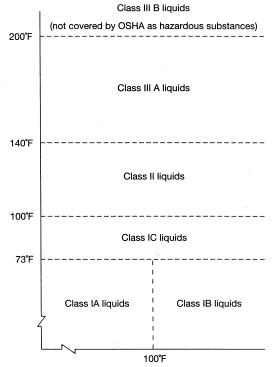


Unlock Deck
Unlock for access to all 88 flashcards in this deck.
Unlock Deck
k this deck
43
54.Which of the following is not considered a flammable liquid?
A)acetone
B)gasoline
C)propane
D)carbon disulfide
A)acetone
B)gasoline
C)propane
D)carbon disulfide

Unlock Deck
Unlock for access to all 88 flashcards in this deck.
Unlock Deck
k this deck
44
46.Automatic sprinkling systems are required in paint spray areas.

Unlock Deck
Unlock for access to all 88 flashcards in this deck.
Unlock Deck
k this deck
45
48.Combustible residues contribute to the largest proportion of spray booth fires.

Unlock Deck
Unlock for access to all 88 flashcards in this deck.
Unlock Deck
k this deck
46
56.The principal basis for classification of flammable liquids is:
A)flashpoint
B)firepoint
C)volatility
D)autoignition temperature
A)flashpoint
B)firepoint
C)volatility
D)autoignition temperature

Unlock Deck
Unlock for access to all 88 flashcards in this deck.
Unlock Deck
k this deck
47
59.Which of the following is used to extinguish LPG fires?
A)dry chemical portable fire extinguishers
B)water
C)CO2
D)BLEVE units
A)dry chemical portable fire extinguishers
B)water
C)CO2
D)BLEVE units

Unlock Deck
Unlock for access to all 88 flashcards in this deck.
Unlock Deck
k this deck
48
50.Pure propane has a characteristic odor.

Unlock Deck
Unlock for access to all 88 flashcards in this deck.
Unlock Deck
k this deck
49
44.Electrical wiring inside spray booths,subject to deposits of combustible residue,must be in rigid conduit or in boxes or fittings containing no taps,splices,or terminal connections.

Unlock Deck
Unlock for access to all 88 flashcards in this deck.
Unlock Deck
k this deck
50
47.If a sprinkler system is installed inside ventilation ducts for a spray area,sprinkler heads are needed on both sides of the filter system.

Unlock Deck
Unlock for access to all 88 flashcards in this deck.
Unlock Deck
k this deck
51
52.LPG tanks are required to have "bleed off" valves for removing condensed moisture.

Unlock Deck
Unlock for access to all 88 flashcards in this deck.
Unlock Deck
k this deck
52
61.The diagram plots
A)flammability vs.combustibility
B)flash points vs.boiling points
C)liquids vs.vapors
D)class vs.division
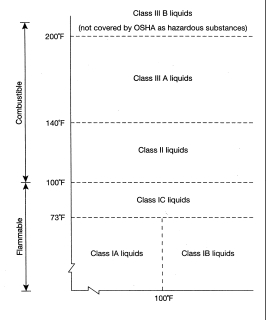
A)flammability vs.combustibility
B)flash points vs.boiling points
C)liquids vs.vapors
D)class vs.division


Unlock Deck
Unlock for access to all 88 flashcards in this deck.
Unlock Deck
k this deck
53
60.Label the temperatures (Fahrenheit)on the axes. 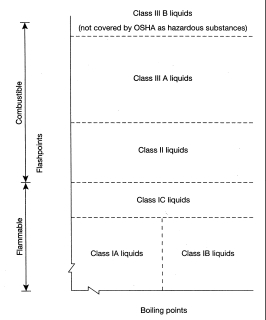


Unlock Deck
Unlock for access to all 88 flashcards in this deck.
Unlock Deck
k this deck
54
49.Spray residue accumulations are difficult to detect and thus do not lead to many OSHA citations.

Unlock Deck
Unlock for access to all 88 flashcards in this deck.
Unlock Deck
k this deck
55
51.Injury from liquid propane while opening the tank valve implies that the valve is defective.

Unlock Deck
Unlock for access to all 88 flashcards in this deck.
Unlock Deck
k this deck
56
58.The most frequently used test for flashpoint is the
A)Cleveland open cup test
B)TAG closed tester
C)Pensky-Martens closed tester method
D)BLEVE test
A)Cleveland open cup test
B)TAG closed tester
C)Pensky-Martens closed tester method
D)BLEVE test

Unlock Deck
Unlock for access to all 88 flashcards in this deck.
Unlock Deck
k this deck
57
45.Electrical equipment of any kind is prohibited in a spray area if subject to deposits of combustible residues.

Unlock Deck
Unlock for access to all 88 flashcards in this deck.
Unlock Deck
k this deck
58
57.The "TAG closed tester" derives its name from
A)the tag indicator device which is suspended in the liquid
B)the term "TEST AND GROUND"
C)the term "TEMPERATURE ABSOLUTE GAUGE"
D)an abbreviation of a French name
A)the tag indicator device which is suspended in the liquid
B)the term "TEST AND GROUND"
C)the term "TEMPERATURE ABSOLUTE GAUGE"
D)an abbreviation of a French name

Unlock Deck
Unlock for access to all 88 flashcards in this deck.
Unlock Deck
k this deck
59
55."Liquids" excluded by NFPA from the definition of "flammable liquid" are those which have a vapor pressure:
A)less than 40 pounds
B)more than 40 pounds
C)less than 100 pounds
D)more than 100 pounds
A)less than 40 pounds
B)more than 40 pounds
C)less than 100 pounds
D)more than 100 pounds

Unlock Deck
Unlock for access to all 88 flashcards in this deck.
Unlock Deck
k this deck
60
43.Small portable spraying apparatus not used repeatedly in the same location is exempt from spray painting standards.

Unlock Deck
Unlock for access to all 88 flashcards in this deck.
Unlock Deck
k this deck
61
83.A common term used by safety engineers,safety managers,and emergency personnel is "bleve".Explain this term,what it means,and how the word is pronounced (what it rhymes with).

Unlock Deck
Unlock for access to all 88 flashcards in this deck.
Unlock Deck
k this deck
62
72.Define the term "flash point".

Unlock Deck
Unlock for access to all 88 flashcards in this deck.
Unlock Deck
k this deck
63
69.What term describing liquid

Unlock Deck
Unlock for access to all 88 flashcards in this deck.
Unlock Deck
k this deck
64
84.Transportation of a new explosive requires prior approval and the assignment of:
A)a flashpoint
B)an emergency fire procedure
C)an EX-number
D)a CAS number
A)a flashpoint
B)an emergency fire procedure
C)an EX-number
D)a CAS number

Unlock Deck
Unlock for access to all 88 flashcards in this deck.
Unlock Deck
k this deck
65
65.The design concept illustrated in the diagram on the left is.

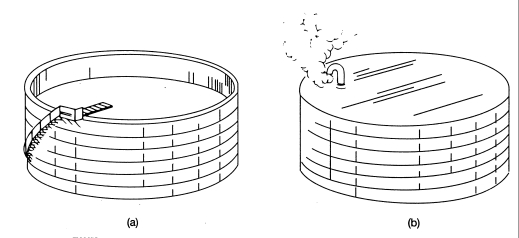



Unlock Deck
Unlock for access to all 88 flashcards in this deck.
Unlock Deck
k this deck
66
77.In qualitative terms describe the relationship between flash point and flammability and combustibility.

Unlock Deck
Unlock for access to all 88 flashcards in this deck.
Unlock Deck
k this deck
67
67.The concentration of flammable vapors in the air that is sufficiently rich to ignite describes which of the following terms?
a.flash point
b.boiling point
c.LEL
d.UEL
a.flash point
b.boiling point
c.LEL
d.UEL

Unlock Deck
Unlock for access to all 88 flashcards in this deck.
Unlock Deck
k this deck
68
81.A glue-making process releases ethylene glycol that becomes generally diluted and interspersed throughout the plant atmosphere.The rate of release is 2.4 cubic feet per hour vapor volume at standard plant temperature and pressure.The plant ventilation system is of the general dilution type with make-up air being supplied at windows and doors throughout the plant area.The plant area is 4000 square feet and the average ceiling height is 12 feet.The problem is to specify the capacity of the general ventilation system required to maintain a steady state condition throughout this process area that protects against both health and safety hazards due to ethylene glycol.For your information in performing calculations the following data is provided:
ETHYLENE GLYCOL (CH2OHCH2OH)
Molecular weight: 62.1
Boiling point: 197.5o Celsius
LEL: 3.2%
Firepoint: -13o Celsius
Flash point: 232o Fahrenheit
Autoignition temperature: 752o Fahrenheit
Vapor Pressure: 0.05 mm @ 20o Celsius
PEL: 50 ppm (Ceiling)
(a)Calculate how much exhaust ventilation (in cubic feet per hour,general dilution type)is required to maintain safety hazards below explosive levels.Show your work.
ETHYLENE GLYCOL (CH2OHCH2OH)
Molecular weight: 62.1
Boiling point: 197.5o Celsius
LEL: 3.2%
Firepoint: -13o Celsius
Flash point: 232o Fahrenheit
Autoignition temperature: 752o Fahrenheit
Vapor Pressure: 0.05 mm @ 20o Celsius
PEL: 50 ppm (Ceiling)
(a)Calculate how much exhaust ventilation (in cubic feet per hour,general dilution type)is required to maintain safety hazards below explosive levels.Show your work.

Unlock Deck
Unlock for access to all 88 flashcards in this deck.
Unlock Deck
k this deck
69
80.A room that measures 12'x 15'x 10' has general dilution exhaust ventilation of 1 room change per hour to prevent explosion.Calculate the maximum tolerable level of gasoline vapor leaking into the room atmosphere.State any necessary assumptions.Gasoline has the following characteristics:
FLASH POINT: -40OF
BOILING POINT: 36.1OC
LEL: 1.5%
UEL: 7.8%
VAPOR DENSITY: 2.48
FLASH POINT: -40OF
BOILING POINT: 36.1OC
LEL: 1.5%
UEL: 7.8%
VAPOR DENSITY: 2.48

Unlock Deck
Unlock for access to all 88 flashcards in this deck.
Unlock Deck
k this deck
70
71.What term describing flammable liquids

Unlock Deck
Unlock for access to all 88 flashcards in this deck.
Unlock Deck
k this deck
71
74 The temperature above which a flammable liquid gives off vapors too rich ignite is called
a.firepoint
b.flash point
c.LEL
d.UEL
e.none of the above
a.firepoint
b.flash point
c.LEL
d.UEL
e.none of the above

Unlock Deck
Unlock for access to all 88 flashcards in this deck.
Unlock Deck
k this deck
72
68.What term describing flammable liquids

Unlock Deck
Unlock for access to all 88 flashcards in this deck.
Unlock Deck
k this deck
73
63.Which of the following characteristics is indicated by the diagram?
A)flash point
B)boiling point
C)UEL
D)none of the above
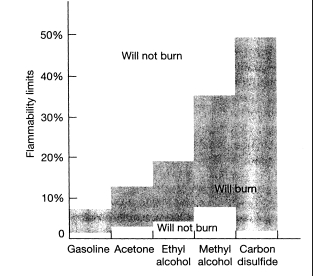
A)flash point
B)boiling point
C)UEL
D)none of the above


Unlock Deck
Unlock for access to all 88 flashcards in this deck.
Unlock Deck
k this deck
74
82.Under certain conditions,combustible liquids become as easily ignitable as flammable liquids at room temperature.Explain these conditions and how they relate to flashpoint.

Unlock Deck
Unlock for access to all 88 flashcards in this deck.
Unlock Deck
k this deck
75
64.Which of the following parameters of flammable liquids is shown on the diagram?
A)flash point
B)boiling point
C)LEL
D)none of the above
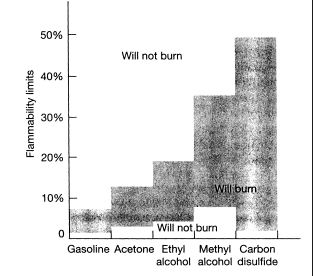
A)flash point
B)boiling point
C)LEL
D)none of the above


Unlock Deck
Unlock for access to all 88 flashcards in this deck.
Unlock Deck
k this deck
75
4/vs = 3.2% = 0.032
vs = 2.4/0.032 = 160 ft3/hr
(b)Calculate how much exhaust ventilation (in cubic feet per hour,general dilution type)is required to maintain health hazards below OSHA-specified Action Levels (AL).Show your work.
vs = 2.4/0.032 = 160 ft3/hr
(b)Calculate how much exhaust ventilation (in cubic feet per hour,general dilution type)is required to maintain health hazards below OSHA-specified Action Levels (AL).Show your work.

Unlock Deck
Unlock for access to all 88 flashcards in this deck.
Unlock Deck
k this deck
76
79.Calculate the amount of general exhaust ventilation (in room changes per hour)needed to control (prevent explosion)a general release of gasoline vapors of 4 cubic feet per minute in a room that measures 12'x 15'x 10'.State any necessary assumptions.Gasoline has the following characteristics:
FLASH POINT: -40OF
BOILING POINT: 36.1OC
LEL: 1.5%
UEL: 7.8%
VAPOR DENSITY: 2.48
FLASH POINT: -40OF
BOILING POINT: 36.1OC
LEL: 1.5%
UEL: 7.8%
VAPOR DENSITY: 2.48

Unlock Deck
Unlock for access to all 88 flashcards in this deck.
Unlock Deck
k this deck
77
70.What term describing flammable liquids

Unlock Deck
Unlock for access to all 88 flashcards in this deck.
Unlock Deck
k this deck
78
78.Which of the following characteristics is indicated by the diagram?
a.flash point
b.boiling point
c.LEL
d.none of the above
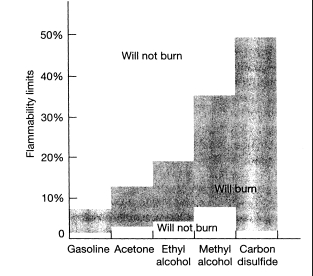
a.flash point
b.boiling point
c.LEL
d.none of the above


Unlock Deck
Unlock for access to all 88 flashcards in this deck.
Unlock Deck
k this deck
79
4/vh = 50 ppm = 0.000050
vh = 2.4/0.000050 = 48000 ft3/hr
(see continuation on next page)
(c)Calculate how many plant area room changes per hour the level of ventilation calculated in part (b)would represent.Show your work.
vh = 2.4/0.000050 = 48000 ft3/hr
(see continuation on next page)
(c)Calculate how many plant area room changes per hour the level of ventilation calculated in part (b)would represent.Show your work.

Unlock Deck
Unlock for access to all 88 flashcards in this deck.
Unlock Deck
k this deck



